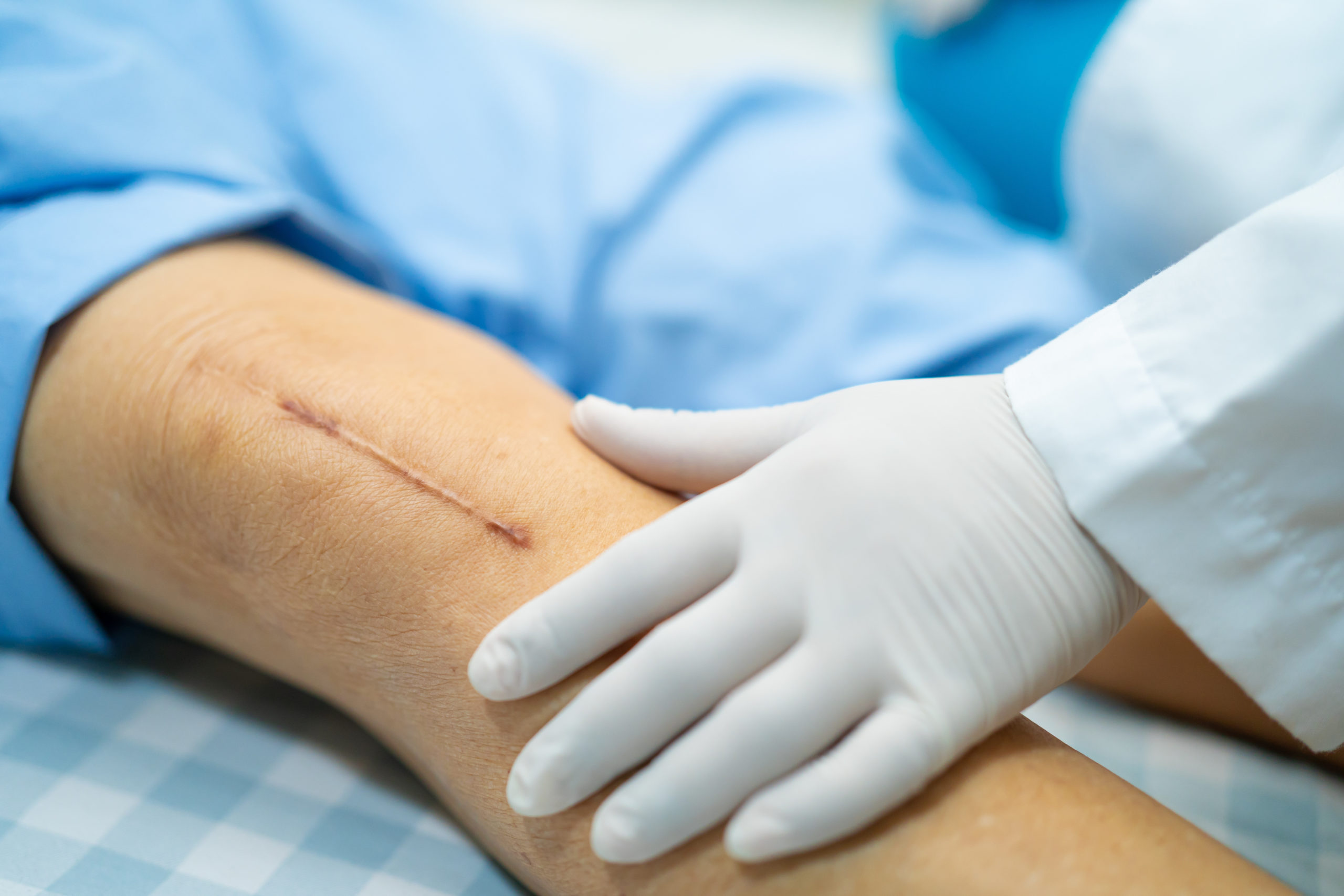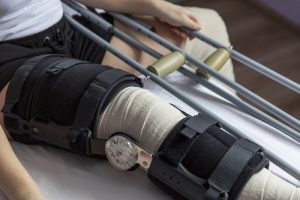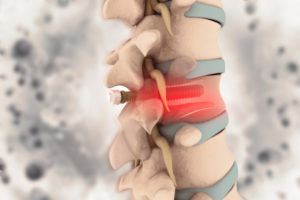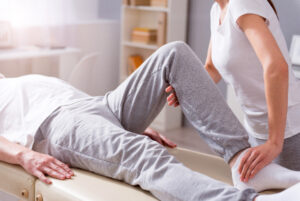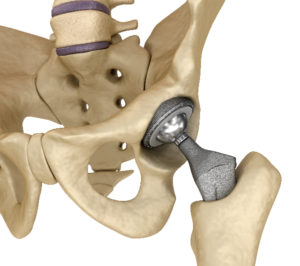Total knee replacements are becoming more and more prevalent in the United States due to older age, obesity, and incidences of arthritis.
An article titled Prevalence of Total Hip and Knee Replacement in the United States (LINK), reports 4.7 million individuals (3.0 million women and 1.7 million men) with total knee replacements in 2010, and that number is expected to increase.
Furthermore, an article titled Rates of Total Joint Replacement in the United States: Future Projections to 2020–2040 Using the National Inpatient Sample (LINK), predicted that total knee replacements will increase by 75% in the year 2025, 129% by the year 2030, and a whopping 284% by the year 2040.
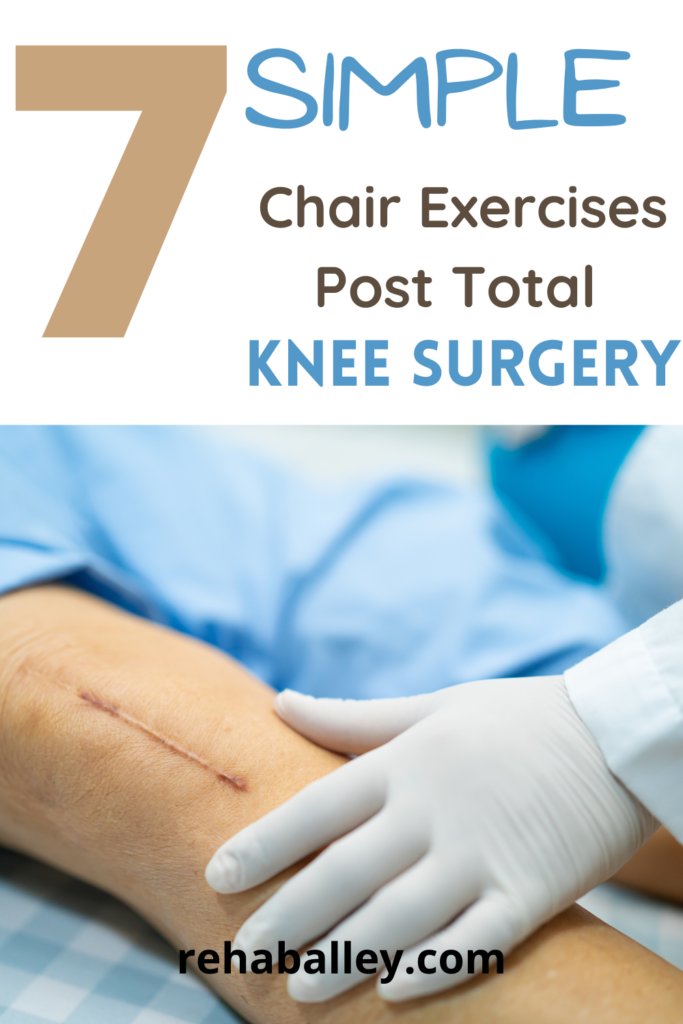
The current and future changes of Medicare (LINK) and reimbursements further impact this trend. For example, individuals with total knee replacement, overall, may be experiencing fewer and fewer days in acute or inpatient rehabilitation following total knee surgery.
This is why it is so important to know your options when it comes to rehabilitation (LINK), equipment needs (LINK), as well as exercises following total knee surgery.
Property of rehaballey.com
In this blog, I will be discussing 7 simple chair exercises that can be performed during the early phases of rehabilitation following total knee arthroplasty.
These exercises are designed to improve blood flow, range-of-motion, strength, as well as reduce swelling in your knee.
It is important to start performing exercises as early as possible following a total knee replacement to improve range-of-motion and reduce the occurrence of scar tissue that can permanently decrease your knee range-of-motion.
This permanent decrease in range-of-motion can impact your overall daily function and quality-of-life.
Property of rehaballey.com
So without further ado, let’s discuss these 7 simple chair exercises post-acute total knee surgery to get you on your way to functioning at your optimal potential.
Disclaimer: Exercises shown in this blog are for general educational and instructional purposes only; to be used as a guide for exercises that have already been prescribed by A doctor, physical therapist, or other healthcare professional.
If you are experiencing symptoms relating to knee dysfunction, and/or previously had or awaiting surgery, a referral from a doctor AND an evaluation from a licensed physical therapist is required before Any exercises can be initiated.
DISCLAIMER (LINK) Continuation of this blog content beyond this point signifies your agreement to the disclaimer and the above statement
BLOG DEFINITIONS
- Knee Flexion- bending the knee
- Knee Extension– straightening the knee
- Passive– occurring naturally with no force required on you or your muscles
- Range-of-motion (ROM)– Movement of the joint
- Acute– sudden onset, early stages of injury or illness usually occurring within a few days or weeks
- Proximal– the end of a muscle or joint closest to the center of the body
**These words will be in Parenthesis throughout the blog for your reference**
- TOE RAISES
- Sit in a chair with your back against the backrest
- Maintain good upright posture
- Place both feet flat on the floor
- Raise both your feet until your forefoot is off of the floor, and toes facing the ceiling. (The heel of your foot should still be on the floor)
- Place your forefoot and toes back down to the floor, and repeat
Benefit of Exercise: This exercise is beneficial after (acute) knee surgery by creating a muscle pump to reduce swelling in the lower leg.
- HEEL RAISES
- Sit in a chair with your back against the backrest
- Maintain a good upright posture
- Place both feet flat on the floor
- Raise both your heels of the floor (Your forefoot and toes should still be on the floor)
- Place your heel back down to the floor, and repeat
Benefit of Exercise: This exercise, like the one above, is beneficial after (acute) knee surgery by creating a muscle pump to reduce swelling in the lower leg.
- LONG ARC QUAD
- Sit in a chair with your back against the backrest
- Maintain a good upright posture
- Place both feet flat on the floor
- Take one leg and straighten your knee out in front of you as far as you can
- Place your foot back down on the floor, and repeat on the other side.
Benefit of Exercise: Strengthens the quad muscle responsible for straightening your knee, which will be compromised and weakened after surgery.
- HIP FLEXION/MARCHING
- Sit in a chair with your back against the backrest
- Maintain a good upright posture
- Place both feet flat on the floor
- Take one leg and raise your knee straight up toward the ceiling, place your foot back down on the floor, and repeat on the other side.
Benefit of Exercise: Strengthens the hip flexors, which include the (proximal) end of the quad muscle while providing a light, (passive) stretch into knee (flexion).
- HEEL SLIDES
- Sit in a chair with your back against the backrest
- Maintain a good upright posture
- Place both feet flat on the floor
- Keep one foot on the floor and slide it back as far as you can, hold this position for 3-5 seconds, then slide the foot back forward to the starting position.
- Repeat on the other side.
Benefit of Exercise: Improves knee (flexion) or bending of the knee. One of the most recommended exercises after knee surgery.
Property of rehaballey.com
Alley Tips: After the acute phase of rehabilitation, it is recommended that you have at least 90 degrees of knee flexion in your knee. This (range-of-motion) can be measured via a device called a goniometer by your doctor or therapist.
- QUAD SETS
- Sit in a chair with your back against the backrest
- Maintain a good upright posture
- Place both feet flat on the floor
- Place another chair or stable stool directly in front of you
- Take one foot and place it on the stool in front of you with your knee straight, and toes facing straight up to the ceiling.
- Use the muscles on the top of your thigh to push your knee down toward the floor, hold for 3-5 seconds and repeat.
Benefit of Exercise: Improves knee (extension) (range-of-motion), or straightening of the knee.
Property of rehaballey.com
Alley Tips: After the acute phase of rehabilitation, it is recommended that you have 0 degrees of knee extension, which means you are able to get your knee completely straight.
If you are still having difficulty with this, the Quad Sets exercise listed above can help. You can also perform the Quad Sets exercise laying down on your back.
- ABDUCTION/ADDUCTION
- Sit in a chair with your back against the backrest
- Maintain a good upright posture
- Place both feet flat on the floor
- Take one leg and straighten it out in front of you as far as you can
- Maintain this position and move your leg out to the side as far as you can, then move your leg back to the center and repeat.
Benefit of Exercise: This exercise helps to maintain quadriceps contraction, which helps to straighten the knee; while improving hip strength.
Alley Tips: If you are experiencing intense discomfort, pain or bleeding with these exercises immediately stop and speak to your doctor or surgeon. Note that some discomfort, pain, and feelings of stretching are normal with these exercises.
Alley Tips: Your doctor or therapist will provide you with the appropriate repetition and/or frequency of exercise that will best fit your needs.
For general purposes, Rehab Alley recommends performing at least 20 repetitions of each exercise 2-3 times/day. These repetitions can also be broken down into 2 sets of 10, or 4 sets of 5, etc. to best fit your comfort level.
Property of rehaballey.com
These are my 7 simple chair exercises post-acute total knee surgery that I recommend during the early phases of rehabilitation.
I have personally recommended and issued these exercises to my patients who have received total knee replacements, and I have seen the benefits of these exercises first-hand.
As mentioned in my disclaimer, always speak with your doctor before starting any new exercise regimen.
The exercises mentioned above are general exercises intended to act as an additional resource for you while you are at home, and/or completing rehabilitation.
Although the prevalence of knee surgery is increasing, evidence has shown very good outcomes and quality of life from individuals who have received total knee replacement surgery.
This is not the end, but merely the beginning of your journey to achieving your optimal physical function. GOD BLESS YOUR ENDEAVORS!!

